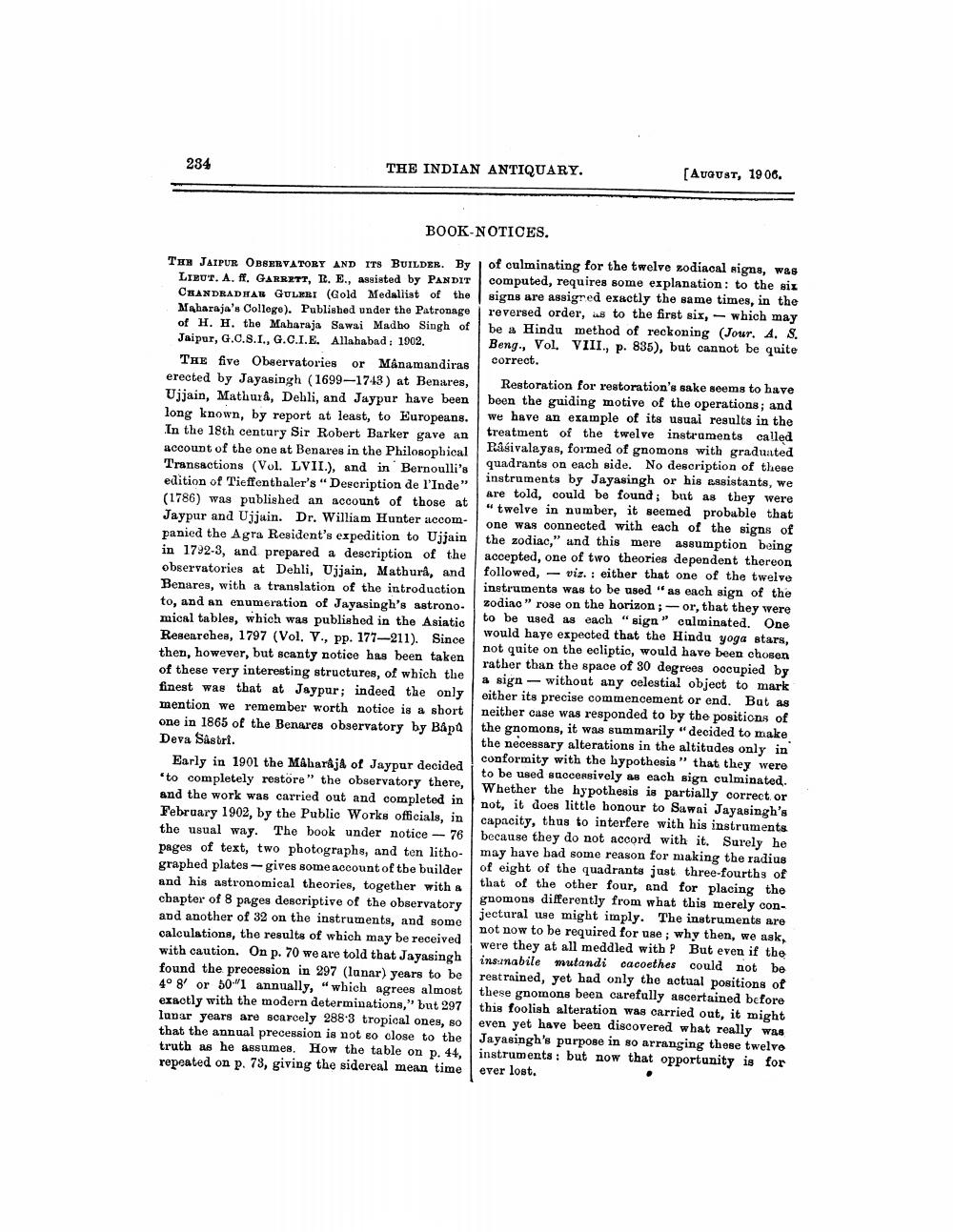________________
284
THE INDIAN ANTIQUARY.
[AUGUST, 1906.
BOOK-NOTICES.
TI JAIPUR OBSERVATORY AND ITS BUILDER. By LIRUR. Aff. GARRETT, R. E., assisted by PANDIT CHANDRADHAB GULIRT (Gold Medallist of the Maharaja's Collego). Published under the Patronage of H. H. the Maharaja Sawai Madho Singh of Jaipur, G.C.S.I., G.C.I.E. Allahabad : 1902.
THE five Observatories or Manamandiras erected by Jayasingh (1699-1743) at Benares, Ujjain, Mathura, Dehli, and Jaypur have been long known, by report at least, to Europeans. In the 18th century Sir Robert Barker gave an account of the one at Benares in the Philosophical Transactions (Vol. LVII.), and in Bernoulli's edition of Tieffenthaler's "Description de l'Inde" (1786) was published an account of those at Jaypur and Ujjain. Dr. William Hunter accompanied the Agra Resident's expedition to Ujjain in 1792-3, and prepared a description of the observatories at Dehli, Ujjain, Mathura, and Benares, with a translation of the introduction to, and an enumeration of Jayasingh's astrono. mical tables, which was published in the Asiatic Researches, 1797 (Vol. Y., pp. 177-211). Since then, however, but scanty notice has been taken of these very interesting structures, of which the finest was that at Jaypur; indeed the only mention we remember worth notice is a short one in 1865 of the Benares observatory by Bapa Deva Sastri.
Early in 1901 the Maharaja of Jaypur decided 'to completely restore" the observatory there, and the work was carried out and completed in February 1902, by the Public Works officials, in the usual way. The book under notice - 76 pages of text, two photographs, and ten lithographed plates-gives some account of the builder and his astronomical theories, together with a chapter of 8 pages descriptive of the observatory and another of 32 on the instruments, and some calculations, the results of which may be received with caution. On p. 70 we are told that Jayasingh found the precession in 297 (lanar) years to be 4° 8' or 50-'1 annually, “which agrees almost exactly with the modern determinations, but 297 lapar years are scarcely 288-3 tropical ones, so that the annual precession is not so close to the truth as he assumes. How the table on p. 44, repeated on p. 73, giving the sidereal mean time
of culminating for the twelve zodiacal signs, W&s computed, requires some explanation: to the siz signs are assigned exactly the same times, in the reversed order, us to the first six, which may be a Hindu method of reckoning (Jour. 4. S. Beng., Vol. VIII, p. 835), but cannot be quite correct.
Restoration for restoration's sake seems to have boon the guiding motive of the operations; and we have an example of its usual results in the treatment of the twelve instruments called Rasivalayas, formed of gnomons with graduated quadrants on each side. No description of these instruments by Jayasingh or his casistants, we Are told, could be found; but as they were
twelve in number, it seemed probable that one was connected with each of the signs of the zodiac," and this mere assumption being accepted, one of two theories dependent thereon followed, - viz. : either that one of the twelve instruments was to be used " as each sign of the zodiac" rose on the horizon; - or, that they were to be used as each "sign" culminated. One would haye expected that the Hindu yoga stars, not quite on the ecliptio, would have been chosen rather than the space of 30 degrees oocupied by a sign - without any celestial object to mark either its precise commencement or end. But as neither case was responded to by the positions of the gnomone, it was summarily "decided to make the necessary alterations in the altitudes only in conformity with the hypothesis" that they were to be used successively as each sign culminated. Whether the hypothesis is partially correct, or not, it does little honour to Sawai Jayasingh's capacity, thus to interfere with his instruments because they do not accord with it. Surely he may have bad some reason for making the radius of eight of the quadrants just three-fourths of that of the other four, and for placing the gnomons differently from what this merely conjectural we might imply. The instruments are not now to be required for use ; why then, we ask, were they at all meddled with P But even if the insunabile mutandi cacoethes could not be restrained, yet had only the actual positions of these gnomone been carefully ascertained before this foolish alteration was carried out, it might even yet have been discovered what really was Jayasingh's purpose in so arranging these twelve instruments: but now that opportunity is for ever lost.




